by Vanessa Zeoli, AECOM Technical Services
A potentially trendsetting countywide survey has just been completed in the floodplains of Monroe County, in the heart of the Pocono Mountains region of northeastern Pennsylvania, identifying all flood-prone historic properties there and laying the groundwork for the development of strategies to better protect the county’s historic built environment from future flood damage.
As detailed in Project Manager Jeremy Young’s February 2015 and September 2015 blog posts, the PA SHPO has been hard at work over the past year developing and implementing the Disaster Planning for Historic Properties Initiative. To help them accomplish their goals, the PA SHPO procured the professional services of AECOM Technical Services, Inc. to conduct Phase 1 of a two-phase effort for four pilot counties: Monroe, Bedford, Cameron, and Philadelphia. This is the first time in Pennsylvania, and one of the first few instances in the nation, that there has been preemptive consideration of the flood hazard vulnerability of historic properties. It is an unprecedented study that is long overdue!
The overarching goal of the Phase 1 studies is to identify historic properties in hazard-affected areas and gather detailed information about their hazard-prone character defining features. This information will facilitate more accurate damage assessments and facilitate the repair of historic properties following future disaster events, including floods, wildfires, and severe wind events. For flood-prone historic properties, another key component of the Phase 1 study is documenting precise building elevation information in relation to the flood stages, particularly at the first floor level and openings (basement windows and doors, for example) where water may enter during a flood event. This will help planners to better understand which historic buildings are most at risk to damage from flooding, and develop alternatives to better protect and reduce damage to these community assets in a way that minimizes changes to their historic character. Such strategies will be integrated into the counties’ FEMA-approved hazard mitigation plans in collaboration with the counties’ emergency management agencies and the PA SHPO through 2017 as part of Phase 2, which will be awarded in a separate contract.
The first county to launch on Phase 1 of the Initiative was Monroe County, located in the beautiful Pocono Mountains region of eastern Pennsylvania. Since Monroe County was already actively engaged in updating their hazard mitigation plan, they were a perfect candidate. Given that the last comprehensive historic resource survey in Monroe County was conducted over 35 years ago, they were in desperate need of updated documentation on their historic buildings!
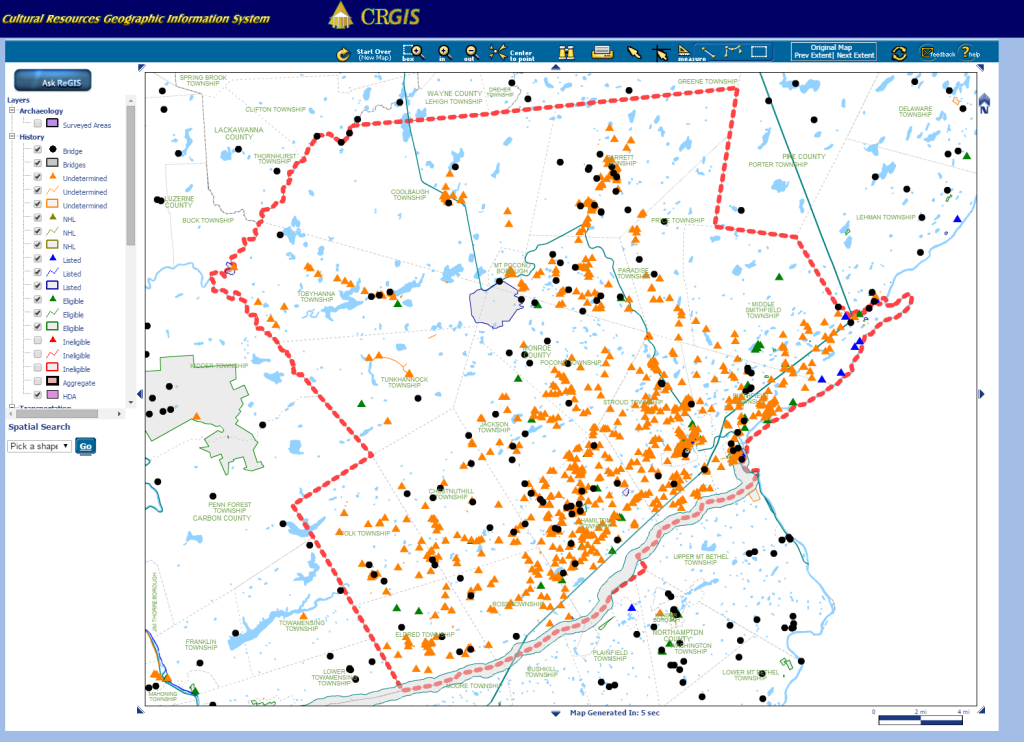
Screenshot from PA SHPO’s CRGIS of all currently documented historic resources in Monroe County, including those listed in and eligible for listing in the National Register of Historic Places, and those for which more documentation is necessary to determine NRHP listing eligibility. The many orange triangles represent the latter, mostly recorded at the time of the 1980 Monroe Countywide Survey, and which required updated documentation.
A 21st Century Historic Resource Survey Strategy
Designing the research and survey methodology for such an unprecedented study and such a vast geographic area required the marriage of traditional techniques and 21st century digital tools. Researchers visited traditional repositories to collect background information and previous studies to become familiar with historic contexts and property types in the project area. AECOM worked with PA SHPO staff to obtain paper files and digital GIS files for all Monroe County resources previously recorded in PA SHPO’s publicly accessible Cultural Resources Geographic Information System (CRGIS). All previously documented historic resources were mapped in GIS along with the FEMA 100-year and 500-year floodplain boundaries and property-specific parcel data containing information on approximate building construction dates. This allowed the team to identify concentrations of flood-prone and potentially historic properties and strategically plan the survey effort prior to the deployment of staff into the field.
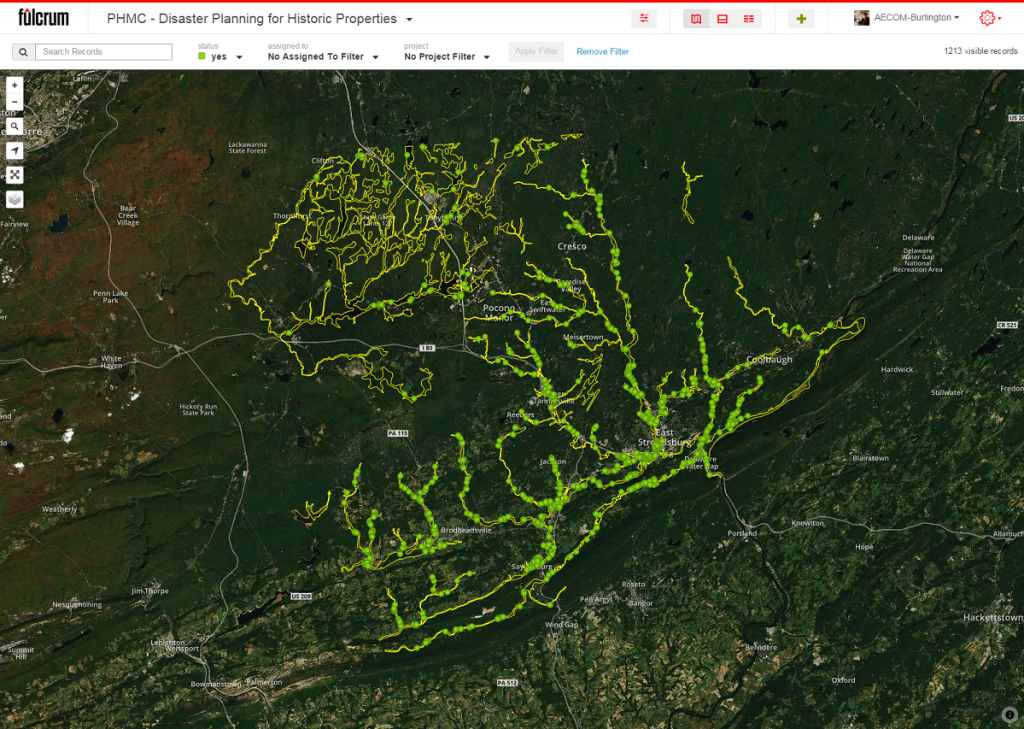
Screenshot from AECOM’s web-based electronic data collection tool Fulcrum, used by the survey teams in the field to document Monroe County’s flood-prone historic resources. The county’s floodplains are shown in yellow, and green points represent each of the buildings surveyed by the team. In total, over 1,600 flood-prone properties in the county were assessed by the team for potential National Register eligibility.
High-Tech Fieldwork
In order to efficiently capture data in the field and minimize desktop analysis, AECOM utilized Wi-Fi-connected hand-held tablets in the field to record property specific information using a web-based application called Fulcrum that was custom designed for the project. The application allowed the teams to toggle between GIS maps and aerial images of the project area and a pre-designed form (made up of drop-down menus and free text fields) to record important physical information about the historic properties including the exact location of the historic buildings and structures on the property. Since information from CRGIS was pre-loaded into the database, the teams were also able to update physical and locational information of previously recorded resources that was incorrect or had changed since they were last surveyed. Following closely behind the architectural survey teams was the elevation team. Armed with a laser range-finder, a Real Time Kinematic (RTK) unit, a Global Positioning System (GPS) unit, and a tablet computer to record elevation points, the elevation team visited each of the significant properties in the floodplain. Much of this data captured during the survey will be funneled back into the PA SHPO’s CRGIS system so that it will be available for future studies.
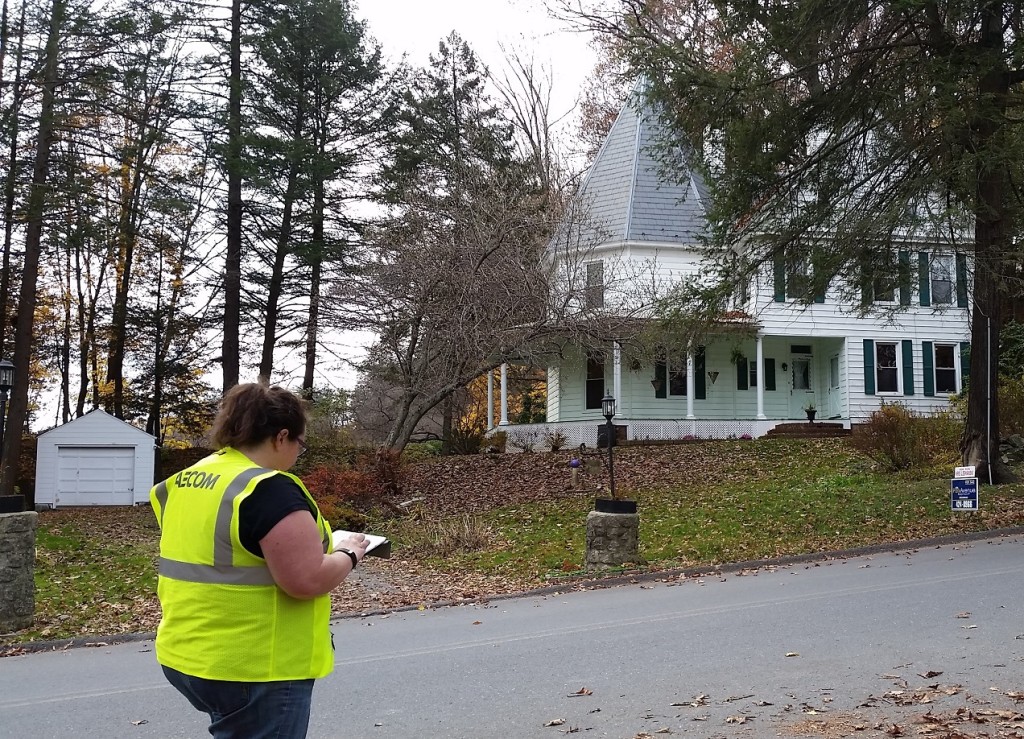
AECOM team member Jennifer Robinson records data on an Android tablet for the circa 1862 Reynolds House in Hamilton Twp.
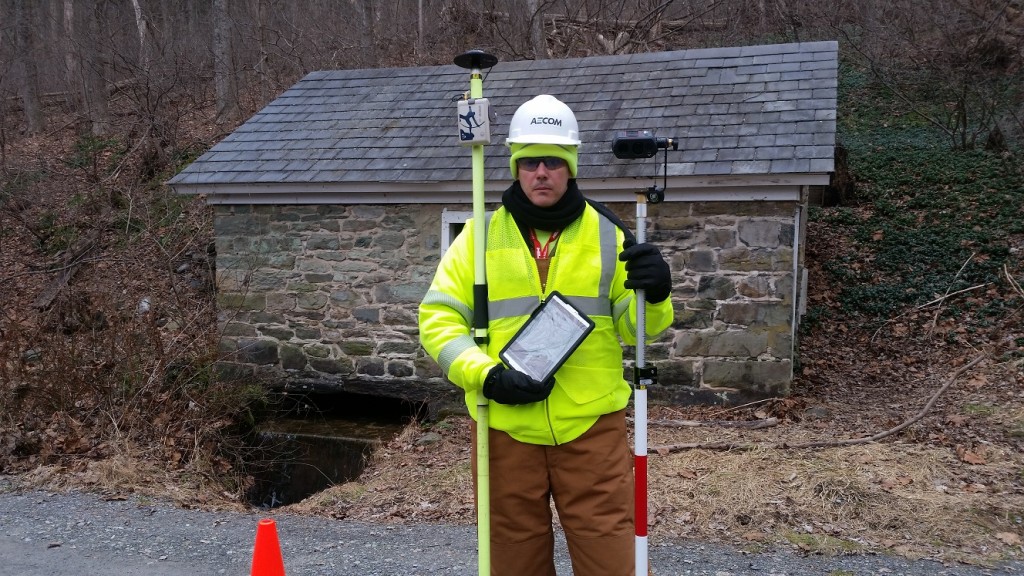
AECOM team member Raymond Dissinger displays the high-tech gadgets used to collect highly accurate building elevation data, after taking measurements for a circa 1830 spring house in Middle Smithfield Twp.
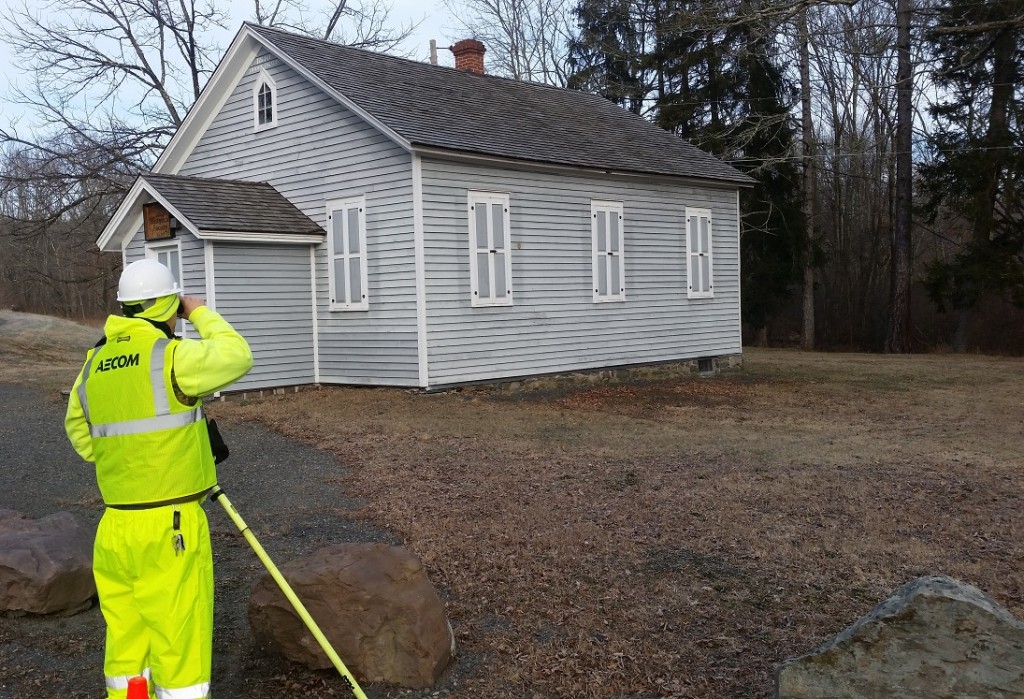
AECOM team member Raymond Dissinger collects detailed building elevation measurements for the former one-room Appenzell school house (circa 1840) in the area once known as “Jackson Corners” in Jackson Township, Monroe County.
Documenting the Flood-Prone Village of Shawnee on Delaware
One area where the survey teams were able to put their technology to good use was the quaint village of Shawnee on Delaware in Smithfield Township. Much of the village is located on the north shore of the Delaware River and falls squarely within the floodplain. Previously surveyed in 1980 as part of the countywide Monroe County Historic Resource Survey, data on the physical condition of the buildings was outdated and in some cases, their precise locations incorrect. Using the mapped layers of CRGIS data and the floodplain boundaries, AECOM was able to resurvey the area and capture building elevation data to inform the mitigation strategies that will be developed during Phase 2 of the Monroe County Disaster Planning for Historic Properties (historic preservation/hazard mitigation integration) project. The good news is that while many of the buildings in the village had weathered previous floods, they were still largely intact! The village is a an early river town first settled by Europeans in the mid-18th century and later became a popular Pocono resort destination when wealthy New York industrialist and businessman Charles Campbell Worthington relocated to his summer home there and built the Buckwood Inn (now the Shawnee Inn) in 1904.
In addition to the Buckwood Inn/Shawnee Inn, other notable and flood-prone historic buildings in the village of Shawnee on Delaware include the following:
- Fort DePui (circa 1727/1785)
- Shrader-Sittig House (circa 1741/1810)
- Miredl/Stony Brook Inn (circa 1853)
- Shawnee General Store (circa 1859)
- Transue House (circa 1870);
- Eagle Rock Cottage (circa 1850).
- Transue House (circa 1870) in Smithfield Twp.
- Eagle Rock Cottage (circa 1850) in Smithfield Twp.
- Shawnee General Store (circa 1859) in Smithfield Twp.
- Miredl/Stony Brook Inn (circa 1853) in Smithfield Twp.
- Shrader-Sittig House (circa 1741/1810) in Smithfield Twp.
- Fort DePui (circa 1727/1785) in Smithfield Twp.
These buildings, some seemingly ordinary, exemplify the character of Smithfield Township and contribute to residents’ and visitors’ sense of place. Should these buildings be destroyed during a future flood event, the community could risk losing part of its cultural heritage and identity.
Stay tuned for AECOM’s follow-up blog posts in the fall, which will present the findings of the flood-prone historic resource identification surveys in Bedford and Cameron counties, slated to begin this spring!
Vanessa Zeoli is a Senior Architectural Historian from AECOM Technical Services, Inc., with over 13 years of historic preservation and cultural resources management experience throughout Pennsylvania and the U.S. Based in AECOM’s Conshohocken office, she serves as the Survey Team Leader for the PA SHPO’s Disaster Planning for Historic Properties Phase 1 (historic resource survey) projects in Monroe, Bedford, and Cameron counties. Vanessa earned a Master of Historic Preservation degree from the University of Kentucky in 2007 and a B.A. in History from Millersville University of Pennsylvania in 1999.
Comment Policy
PHMC welcomes and encourages topic-related comments on this blog. PHMC reserves the right to remove comments that in PHMC’s discretion do not follow participation guidelines.
Commenters and Comments shall be related to the blog post topic and respectful of others who use this site.
Commenters and Comments shall not: use language that is offensive, inflammatory or provocative (this includes, but is not limited to, using profanity, obscene, or vulgar comments); disparage other commenters or people; condone illegal activity; identify the location of known or suspected archeological sites; post personal information in comments such as addresses, phone numbers, e-mail addresses or other contact details, which may relate to you or other individuals; impersonate or falsely claim to represent a person or an organization; make any commercial endorsement or promotion of any product, service or publication.
If you would like to comment on other topics not related to this blog post but related to PHMC, please fill out the PHMC Contact Us Form.

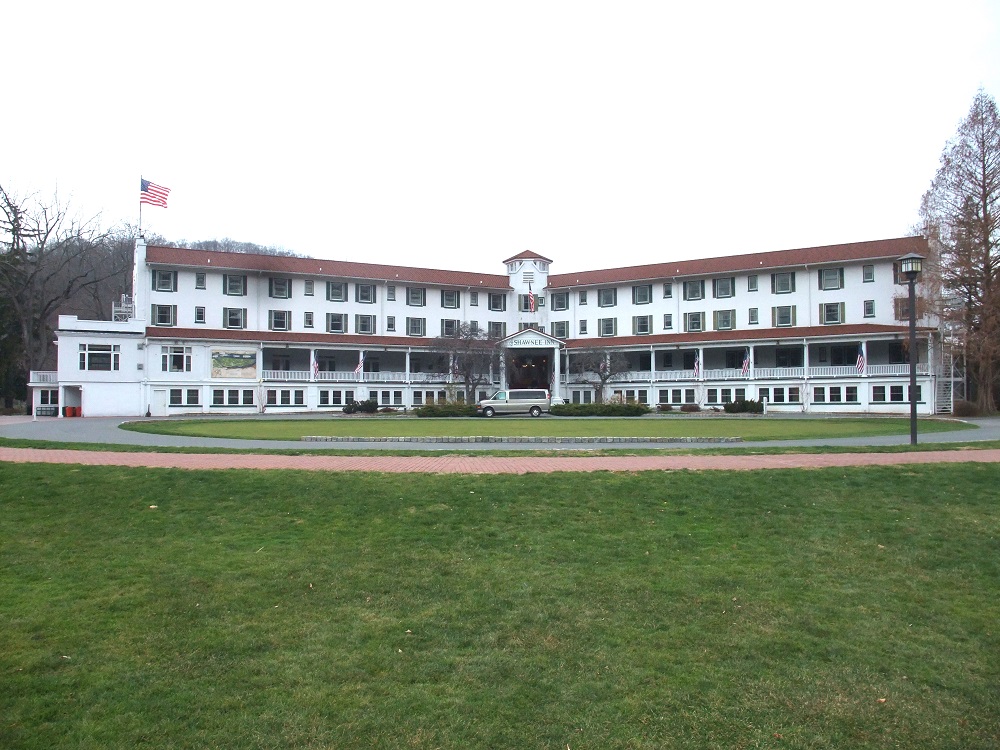
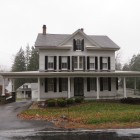
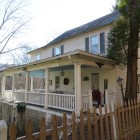
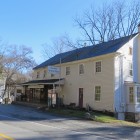
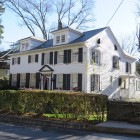
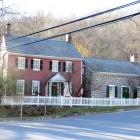
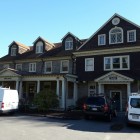
Really valuable information..Thanks for sharing..